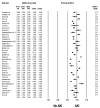Incidence and Impact of Acute Kidney Injury after Liver Transplantation: A Meta-Analysis
- PMID: 30884912
- PMCID: PMC6463182
- DOI: 10.3390/jcm8030372
Incidence and Impact of Acute Kidney Injury after Liver Transplantation: A Meta-Analysis
Abstract
Background: The study's aim was to summarize the incidence and impacts of post-liver transplant (LTx) acute kidney injury (AKI) on outcomes after LTx.
Methods: A literature search was performed using the MEDLINE, EMBASE and Cochrane Databases from inception until December 2018 to identify studies assessing the incidence of AKI (using a standard AKI definition) in adult patients undergoing LTx. Effect estimates from the individual studies were derived and consolidated utilizing random-effect, the generic inverse variance approach of DerSimonian and Laird. The protocol for this systematic review is registered with PROSPERO (no. CRD42018100664).
Results: Thirty-eight cohort studies, with a total of 13,422 LTx patients, were enrolled. Overall, the pooled estimated incidence rates of post-LTx AKI and severe AKI requiring renal replacement therapy (RRT) were 40.7% (95% CI: 35.4%⁻46.2%) and 7.7% (95% CI: 5.1%⁻11.4%), respectively. Meta-regression showed that the year of study did not significantly affect the incidence of post-LTx AKI (p = 0.81). The pooled estimated in-hospital or 30-day mortality, and 1-year mortality rates of patients with post-LTx AKI were 16.5% (95% CI: 10.8%⁻24.3%) and 31.1% (95% CI: 22.4%⁻41.5%), respectively. Post-LTx AKI and severe AKI requiring RRT were associated with significantly higher mortality with pooled ORs of 2.96 (95% CI: 2.32⁻3.77) and 8.15 (95%CI: 4.52⁻14.69), respectively. Compared to those without post-LTx AKI, recipients with post-LTx AKI had significantly increased risk of liver graft failure and chronic kidney disease with pooled ORs of 3.76 (95% CI: 1.56⁻9.03) and 2.35 (95% CI: 1.53⁻3.61), respectively.
Conclusion: The overall estimated incidence rates of post-LTx AKI and severe AKI requiring RRT are 40.8% and 7.0%, respectively. There are significant associations of post-LTx AKI with increased mortality and graft failure after transplantation. Furthermore, the incidence of post-LTx AKI has remained stable over the ten years of the study.
Keywords: Acute kidney injury; Acute renal failure; Epidemiology; Incidence; Liver Transplantation; Meta-analysis; Systematic reviews; Transplantation.
Conflict of interest statement
The authors declare no conflict of interest.
Figures






References
-
- Mehta R.L., Burdmann E.A., Cerdá J., Feehally J., Finkelstein F., García-García G., Godin M., Jha V., Lameire N.H., Levin N.W., et al. Recognition and management of acute kidney injury in the International Society of Nephrology 0by25 Global Snapshot: A multinational cross-sectional study. Lancet. 2016;387:2017–2025. doi: 10.1016/S0140-6736(16)30240-9. - DOI - PubMed
-
- Mehta R.L., Burdmann E.A., Cerdá J., Feehally J., Finkelstein F., García-García G., Godin M., Jha V., Lameire N.H., Levin N.W., et al. International Society of Nephrology’s 0by25 initiative for acute kidney injury (zero preventable deaths by 2025): A human rights case for nephrology. Lancet. 2015;385:2616–2643. doi: 10.1016/S0140-6736(15)60126-X. - DOI - PubMed
LinkOut - more resources
Full Text Sources

